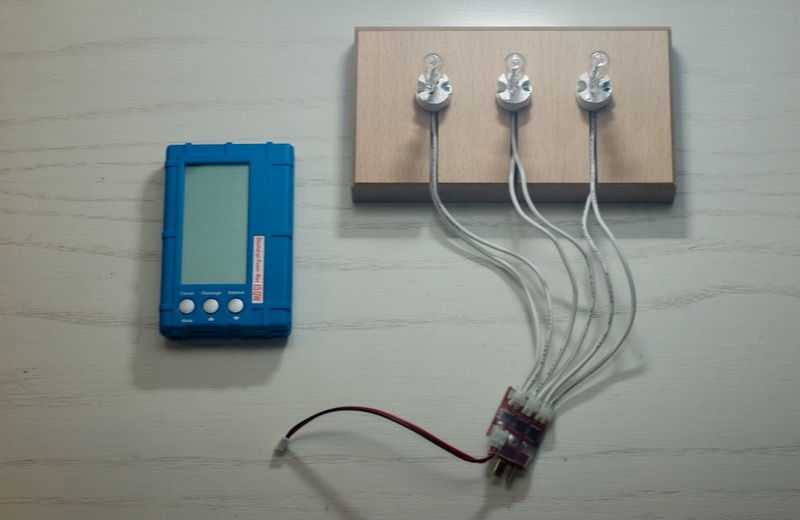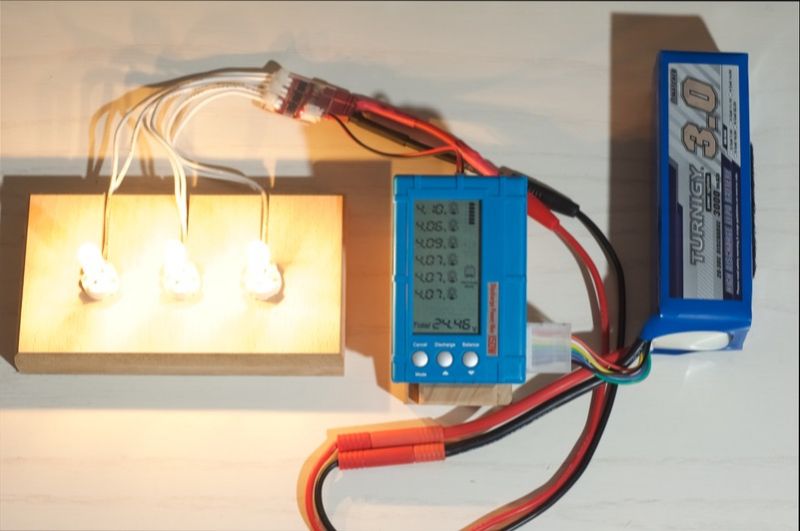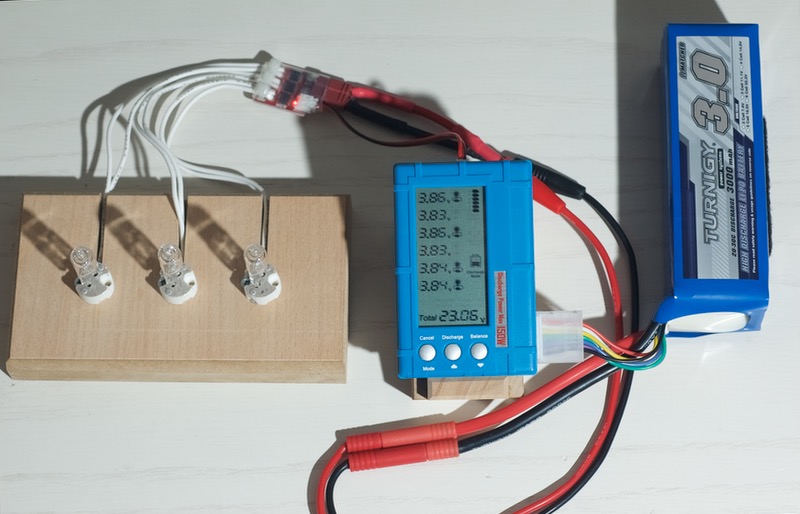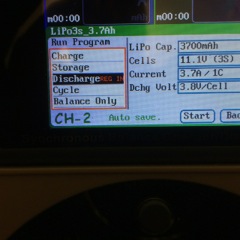- Thank you received: 0
Battery Discharger to Storage Voltage
-
 Topic Author
Topic Author
- New Member
-

Less
More
9 years 11 months ago #6548
by
Battery Discharger to Storage Voltage was created by
No eBay APP ID and/or Cert ID defined in Kunena configurationA recent example of gravity’s wonderful power left me with a slight predicament, 3 fully charged batteries and no plane to fly them in. My charger has a discharge to storage voltage option, but it takes hours and hours, and yet more hours to discharge one battery, and I don’t think it is great for the charger either.
So I was on the lookout for a fairly painless discharging option, and one that ideally discharges to a preset level. Cheap would be good too.
So for less than £14 you can get this:
A little research on another forum showed that it did actually work.
You get a cell checker/balancer and with this version an extension circuit board that you plug your battery into, and three 50W halogen light bulbs. On the cell checker/balancer you dial in your desired discharged voltage (in my case 3.84V), and it then turns on and off the lights as it ‘burns’ away the power.
I mounted the lights on a block of wood, I’ll put a guard around them later. As with any halogen light bulb, never touch the quartz envelope with your bare fingers, the oils on your fingers creates a hot spot and will cause the quartz envelope to weaken/melt/explode.
The circuit board that the battery plugs into has a deans connector, so I made up a short deans to 4mm socket lead so that I could plug in whatever charge lead I needed for the particular battery.
It took 31 minutes to bring a fully charged 3000mAh 6S battery down to 3.84V per cell. It does seem to ‘balance’ the cells throughout, but the last little bit of balancing down to the final voltage takes a while, so once it had stopped using the light bulbs I stopped it and the cells were all within +/-0.01V of each other according to my iCharger .
So I was on the lookout for a fairly painless discharging option, and one that ideally discharges to a preset level. Cheap would be good too.
So for less than £14 you can get this:
A little research on another forum showed that it did actually work.
You get a cell checker/balancer and with this version an extension circuit board that you plug your battery into, and three 50W halogen light bulbs. On the cell checker/balancer you dial in your desired discharged voltage (in my case 3.84V), and it then turns on and off the lights as it ‘burns’ away the power.
I mounted the lights on a block of wood, I’ll put a guard around them later. As with any halogen light bulb, never touch the quartz envelope with your bare fingers, the oils on your fingers creates a hot spot and will cause the quartz envelope to weaken/melt/explode.
The circuit board that the battery plugs into has a deans connector, so I made up a short deans to 4mm socket lead so that I could plug in whatever charge lead I needed for the particular battery.
It took 31 minutes to bring a fully charged 3000mAh 6S battery down to 3.84V per cell. It does seem to ‘balance’ the cells throughout, but the last little bit of balancing down to the final voltage takes a while, so once it had stopped using the light bulbs I stopped it and the cells were all within +/-0.01V of each other according to my iCharger .
Please Log in or Create an account to join the conversation.
- kevinross
-

- Offline
- Platinum Member
-

Less
More
- Posts: 1028
- Thank you received: 583
9 years 11 months ago - 9 years 11 months ago #6551
by kevinross
Replied by kevinross on topic Battery Discharger to Storage Voltage
An effective solution if your battery cells are well balanced at the start but unsure what the impact would be if the cells were unbalanced. i.e. Suspect it may lead to excessive currents thru the balance leads.
My new I charger cost a bomb but it does have regenerative discharge which dissipates into my leisure battery instead of charger heat sinks.
My new I charger cost a bomb but it does have regenerative discharge which dissipates into my leisure battery instead of charger heat sinks.
Last edit: 9 years 11 months ago by kevinross.
Please Log in or Create an account to join the conversation.
- Phil Ford
-

- Offline
- Administrator
-

Less
More
- Posts: 3163
- Thank you received: 903
9 years 11 months ago - 9 years 11 months ago #6552
by Phil Ford
Replied by Phil Ford on topic Battery Discharger to Storage Voltage
Very imaginative. 
Like Kevin I have a relatively expensive i-Charger 306 (middling size) but these little units can do virtually anything. As I started acquiring more and more leckies and multiple sets of LiPos I knew I would have to fork out for a decent charger /discharger. The other advantage is it dumps the excess electrons back into my lead acid battery.. Your disadvantage is of course having the similarity to watching "paint dry" for 30 mins while the volts drop :lol:
Why bring them down to storage level? Your not going to be without a plane for that long are you?
There used to be TV show many years ago (about 45) where this Guy would knock up devices and gadgets on the cheap out of everyday objects - Heath Robinson. No relation I suppose?
Like Kevin I have a relatively expensive i-Charger 306 (middling size) but these little units can do virtually anything. As I started acquiring more and more leckies and multiple sets of LiPos I knew I would have to fork out for a decent charger /discharger. The other advantage is it dumps the excess electrons back into my lead acid battery.. Your disadvantage is of course having the similarity to watching "paint dry" for 30 mins while the volts drop :lol:
Why bring them down to storage level? Your not going to be without a plane for that long are you?
There used to be TV show many years ago (about 45) where this Guy would knock up devices and gadgets on the cheap out of everyday objects - Heath Robinson. No relation I suppose?
Last edit: 9 years 11 months ago by Phil Ford.
Please Log in or Create an account to join the conversation.
-

- New Member
-

Less
More
- Thank you received: 0
9 years 11 months ago #6555
by
Replied by on topic Battery Discharger to Storage Voltage
nice little doffa.
i wouldnt worry about cell balance at that point, it looks like the discharger is on the main power lead its only measuring on the balance lead. most packs will appear to be out of balance at part/full discharge. That is due to differences between the cells when you charge them back up the differences make them charge differently too so the difference is reversed.
I dont personally worry about storing them full charged.
My understanding is that the issue is down to temperature change. as the temperature goes down the apparent state of charge goes up. so if you charge in your warm house, go to cold field and let the batteries cool then that has the effect them being in an overcharged state.
feel free to correct me if im wrong.
i wouldnt worry about cell balance at that point, it looks like the discharger is on the main power lead its only measuring on the balance lead. most packs will appear to be out of balance at part/full discharge. That is due to differences between the cells when you charge them back up the differences make them charge differently too so the difference is reversed.
I dont personally worry about storing them full charged.
My understanding is that the issue is down to temperature change. as the temperature goes down the apparent state of charge goes up. so if you charge in your warm house, go to cold field and let the batteries cool then that has the effect them being in an overcharged state.
feel free to correct me if im wrong.
Please Log in or Create an account to join the conversation.
-
 Topic Author
Topic Author
- New Member
-

Less
More
- Thank you received: 0
9 years 11 months ago #6560
by
Replied by on topic Battery Discharger to Storage Voltage
Hi Adrian,
I think you are probably right, and I know a lot of people have no issue with leaving their batteries at full charge, I've just always gone to a 'storage' voltage when I don't anticipate flying for a day or two. Normally once I've flown and have a number of exhausted batteries I just charge each one up to storage voltage when I get home. Then all the batteries are at the same voltage so it's easy to balance charge four batteries all at once when I next go and fly.
I don't anticipate the above device to be used a great deal, but will come in handy on those occasions when I need/want to take a fully charged battery to a storage voltage.
I think you are probably right, and I know a lot of people have no issue with leaving their batteries at full charge, I've just always gone to a 'storage' voltage when I don't anticipate flying for a day or two. Normally once I've flown and have a number of exhausted batteries I just charge each one up to storage voltage when I get home. Then all the batteries are at the same voltage so it's easy to balance charge four batteries all at once when I next go and fly.
I don't anticipate the above device to be used a great deal, but will come in handy on those occasions when I need/want to take a fully charged battery to a storage voltage.
Please Log in or Create an account to join the conversation.
- kevinross
-

- Offline
- Platinum Member
-

Less
More
- Posts: 1028
- Thank you received: 583
9 years 11 months ago - 9 years 11 months ago #6578
by kevinross
“Experts” within our hobby promote two opposing / contradicting arguments on effects of temperature and charge / discharge cycles So which is correct ?
As a basic principle, all batteries perform better when warm and experience lower self discharge when cold (the latter had a major impact on previous generation NiCads). This is because lower temperatures slow the chemical process, increase resistance and lowers the cell voltage.
see the last graph in this attached link www.ibt-power.com/bkencel/Lithium-Po-tech.html
Therefore, if you attempt to fully charge a battery at low temperature, you are fighting a reluctant chemical process.
Now take the battery into a warm environment, the chemicals react more efficiently and cell voltage increases. - possibly to an unsafe level.
Thats my understanding irrespective of the cell chemistry.
At a recent presentation by a major R/C Lipo supplier the basic message was - only charge to storage level at lower temperatures and ensure they are at working temperature before bringing them to full charge.
Replied by kevinross on topic Battery Discharger to Storage Voltage
Adrian wrote: nice little doffa.
My understanding is that the issue is down to temperature change. as the temperature goes down the apparent state of charge goes up. so if you charge in your warm house, go to cold field and let the batteries cool then that has the effect them being in an overcharged state.
feel free to correct me if im wrong.
“Experts” within our hobby promote two opposing / contradicting arguments on effects of temperature and charge / discharge cycles So which is correct ?
As a basic principle, all batteries perform better when warm and experience lower self discharge when cold (the latter had a major impact on previous generation NiCads). This is because lower temperatures slow the chemical process, increase resistance and lowers the cell voltage.
see the last graph in this attached link www.ibt-power.com/bkencel/Lithium-Po-tech.html
Therefore, if you attempt to fully charge a battery at low temperature, you are fighting a reluctant chemical process.
Now take the battery into a warm environment, the chemicals react more efficiently and cell voltage increases. - possibly to an unsafe level.
Thats my understanding irrespective of the cell chemistry.
At a recent presentation by a major R/C Lipo supplier the basic message was - only charge to storage level at lower temperatures and ensure they are at working temperature before bringing them to full charge.
Last edit: 9 years 11 months ago by kevinross.
Please Log in or Create an account to join the conversation.
Moderators: DaveBright
Time to create page: 0.609 seconds
Latest Posts
-
-

- Various Gliders from Dave Ambrose ex W.M.A.C Membe...
- In WimborneMac Members / For Sale - Exchange - Wanted
- by 4Pedalsfly
- 1 week 1 day ago
-
-
-

- Ray Ivey's Models
- In WimborneMac Members / For Sale - Exchange - Wanted
- by Phil Ford
- 2 weeks 7 hours ago
-
©
2009 - 2025
WMAC PCF Design






